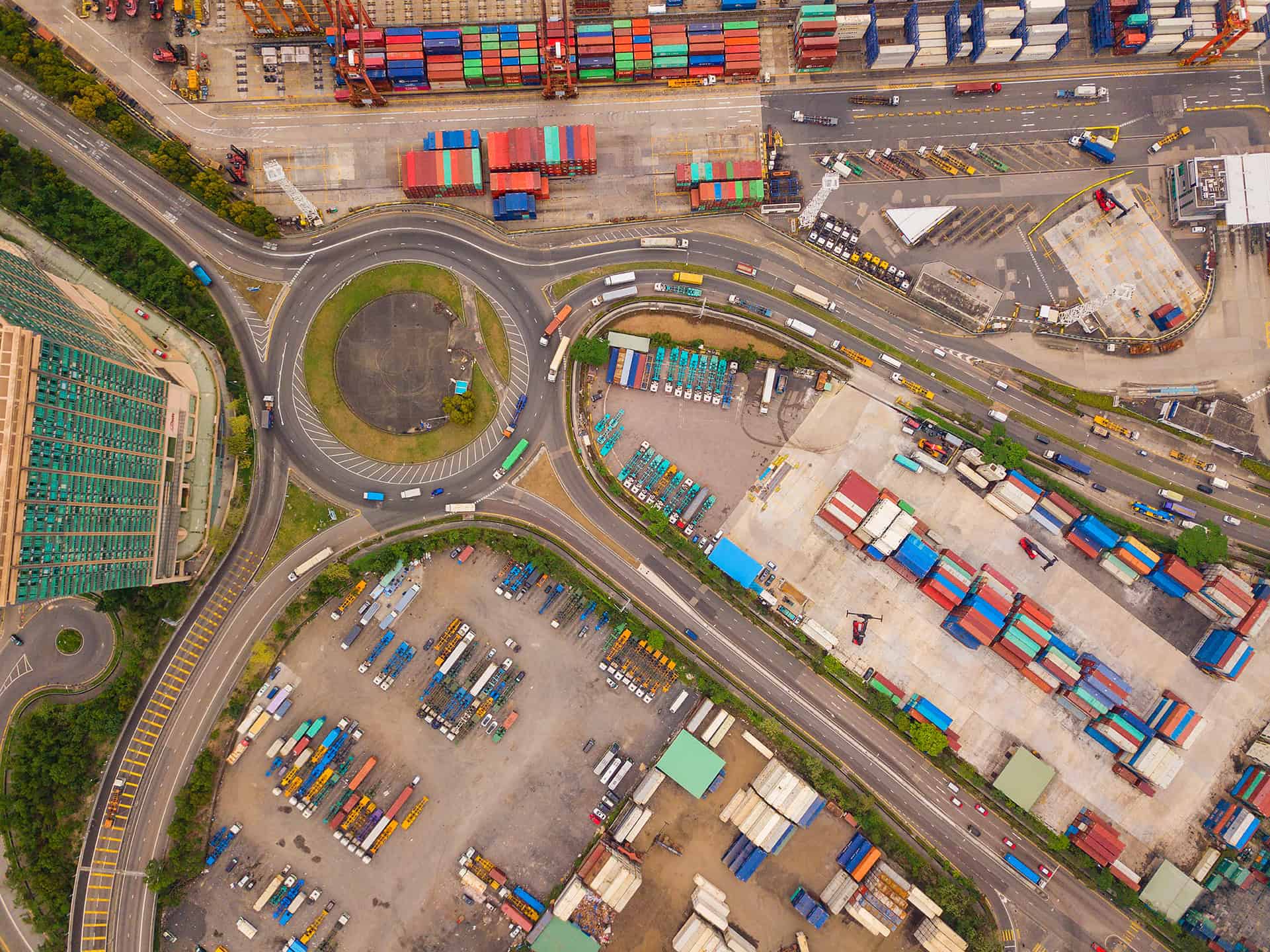
With global commerce at an all-time high, the complexity faced by shippers has increased exponentially. Stricter regulations, geopolitical instability, new competitors, and changing consumer habits are the new normal, and these trends show no signs of abating. As a result, many shipping companies are looking for ways to streamline and simplify supply chain operations and might choose to adopt a transportation management system (TMS), a software platform designed to help businesses manage the complexity of operating across multiple transport modes and regions.
However, with all the TMS options available, it can be challenging to know exactly what to look for. It’s important for a potential buyer to make sure that the vendors they’re evaluating are a good fit for their organization. In this post, we will discuss what TMS software does, how the right TMS can help a company optimize its logistics operations, and strategies that companies can use to evaluate different TMS software providers during their vetting process.
Understanding the basics of TMS software
Historically, logistics providers have not been early adopters of technology, given the time and resources required to implement new platforms or applications. If you’ve ever put off a software update on your computer because you were in the middle of a task, you can understand why: it takes time to update or implement new software, and the process is one-hundred-fold for a global logistics operation that lives or dies by its punctuality.
This means that until recently, many logistics teams have relied on manual processes for documentation and collaboration. These outdated processes not only absorb additional time and manpower, but also create multiple blind spots within a logistics network and put it at risk of human error. TMS software removes that risk by automating transportation activities across all modes and regions, driving transformational efficiency and giving companies the ability to scale. It also allows stakeholders to manage everything from planning and rating, execution, settlement, analytics, and procurement, all from one platform.
With the growth and expansion of modern logistics, we’ve reached a tipping point where the pros of implementing TMS software far outweigh the cons. While the concept of TMS is not new, the evolution of the technology has grown in leaps and bounds. Let’s take a moment to break down how a proven TMS platform can help businesses take control of the chaos and remain agile despite growing supply chain complexity.
How TMS software operates
Fundamentally, a TMS platform employs automation to simplify many of the day-to-day logistics operations and provides increased visibility into every order or shipment. It also connects internal teams to external partners on a common communication platform, giving stakeholders the ability to identify and respond to disruptions, mitigate compliance risks, and streamline operational tasks.
Let’s take a look at some key features of TMS software, and the role it plays in supply chain management.
Five key features of TMS software
Specific to shippers, a TMS platform offers control over multiple essential functions related to planning, execution, analytics, and operations across all modes and regions – all from one single dashboard. Ideally, shippers should look for a TMS platform which includes the following capabilities:
Procurement: Allows shippers to easily manage and nurture relationships with freight carriers
Planning: Allows shippers to intake orders, consolidate orders and shipments, determine routes, select carriers, and plan and choose the most efficient mode of transport based on factors such as distance and cost
Execution: Provides open lines of communication with carriers to facilitate the implementation of the shipment plan
Audit and settlement: Automates the comparison of invoices against contracts and integrates with accounts payable systems
Analytics and reporting: Enables shippers to access analytics and reporting for measuring key performance indicators (KPIs) and understand trends
Role of TMS in supply chain management
Transportation Management System (TMS) software plays a critical role in modern supply chain management that comes down to one word: control. The platform gives shippers agency to bring order to the chaos of global logistics from one place in the cloud. Businesses can effortlessly juggle multiple carriers, optimize routes, and track shipments and performance in real-time, all while keeping a sharp eye on costs.
One of the key benefits of TMS software is real-time visibility into shipping operations, allowing companies to plan, execute, and track the movement of products across all modes of transport. With a TMS, shippers can manage and select the shipping methods that balance efficiency and cost, make informed decisions on the fly, and respond to issues before they become problems. And, by automating logistics operations such as route optimization, load optimization, and freight auditing, a TMS reduces the reliance on manual processes and gives shippers more time and space to focus on strategic thinking.
The connected nature of TMS software also gives shippers the ability to better curate relationships with carriers and improves communication and collaboration between all logistics stakeholders. Inherent data analytics and reporting capabilities give companies valuable insight into logistics performance, enabling them to improve operations by identifying trends and opportunities for growth.
Choosing the right TMS software for your business
Like any other technology investment, choosing a TMS requires extensive evaluation. There are several factors that should be considered, including how well the TMS in question aligns with your needs, how it can improve collaboration with your partners, ease of integration, and how resilient the TMS is to external disruption. It’s important for the buyer to have a good understanding of their own existing needs as well as their desired future state, as a TMS should be scalable with the company’s ambitions.
Six factors to consider when selecting TMS software
The first step in evaluating TMS options is to take a clear look at your business. Where are you now? Where do you want to go? Assess your existing needs and pinpoint areas of opportunity across the business. Next, consider your company’s future growth, and how a TMS could help facilitate that expansion. Once you’ve established these goalposts, you’re ready to dive into a vendor evaluation.
Here are some initial inquiries that you can ask TMS software providers to see if their offering is the right fit for your needs:
How prepared is a TMS software provider to solve for your most complex scenarios?
For many companies, a TMS is about breaking down silos – not just internal silos, but also external silos with suppliers and the various vendors that they work with. If your organization is juggling complex transportational scenarios, it’s important to ensure your potential TMS can handle your scope of operations. Make sure to ask how the TMS would help tackle different geographical needs – what works in one area may not work in another!
How can a vendor help you realize your growth ambitions?
While understanding how a TMS can handle your existing needs is important, you need to know how it will keep up with your logistics needs in five- or ten-years’ time. Look for vendors who can paint a clear picture of how their platform will evolve alongside your business. Transparency is key – the vendor should be able to provide you with a detailed road map and share how their platform will evolve as you grow.
How does the TMS help your company comply with sustainability requirements?
With sustainability becoming such an important part of the supply chain story, it’s important to ensure that your vendors are up to speed. With regulations changing faster than ever and compliance risks lurking deep within sub-tier partner ecosystems, the TMS you choose must be agile and responsive. Have your vendor explain their sustainability credentials during the evaluation process to prove they are ready to handle your sustainability demands today and tomorrow.
How does the TMS integrate with external partner ecosystems and improve collaboration?
A TMS doesn’t exist in a vacuum – it needs to play well with your existing tech ecosystem and external partners. With regulatory scrutiny focused on a supply chain’s multi-tier ecosystems, collaboration with partners is a crucial part of maintaining compliance and assurance. A truly effective TMS should foster collaboration across your entire supply chain network. After all, what good is AI and automation if your TMS can’t connect with your partners?
How does the vendor respond to unforeseen events/disruption?
Like most supply chain operations, modern logistics exists in a climate of pervasive disruptive events. From extreme weather events, geopolitical conflicts, or industrial accidents, your TMS needs to be ready for anything so you can keep your goods moving. Don’t be shy about asking for real-world examples. A good vendor will validate successful deployments of their TMS in these scenarios and provide assurances – sometimes in the form of case studies – that their platform can handle your needs.
What is your strategy around artificial intelligence (AI) and how is it incorporated into your platform?
For a while, there was a lot of hype around artificial intelligence (AI). Much of it revolved around generative AI, such as ChatGPT. But not all AI is created equal. It’s important to understand exactly how a TMS utilizes AI for logistics. Will it automate manual processes? Offer decision support or automated decision-making? Is it about using AI and machine learning (ML) to help your company discover opportunities for growth or improvement? AI requires cleansed, harmonized data to be truly effective. A trusted vendor will be able to provide specifics, so be wary of generic, canned answers to these questions.
Comparing different TMS software solutions
Internal alignment is a major prerequisite for adopting TMS logistics software. Companies often focus on only transportation requirements, but a TMS can impact and influence many departments, including sales, customer service, and finance (both accounts payable and accounts receivable). Understand the pain points of these teams and incorporate them into the process of vetting TMS software providers. Vendors should be willing to have role-centric conversations about the value a TMS can bring to these specific functions.
Like any important purchase, implementing a TMS requires doing your research. Start with a broad scope, by gathering the feedback of industry analysts that rate supply chain vendors. Use their research to narrow providers whose overviews and scores align with your business needs, such as verticality, size, and geography. Then, put on your detective hat and look closely at vendor’s websites. See if their case studies can reflect their claims, and search for industry-specific content that aligns with your needs.
Once it’s time to issue your request for information (RFI), don’t hold back. Include specific details and questions about your critical or complex business challenges and frame your questions to reveal how the TMS actually operates, not just whether it has a particular feature.
Here’s an example: Let’s say the prospective TMS client is a pharmaceutical company. In this specific case, it’s critical that carrier insurance and compliance software are incorporated into the transportation planning decisions. Instead of simply asking whether the TMS is integrated with carrier insurance software, frame the question in a way that forces the TMS provider to give more insight.
Here’s a better way to guide the conversation:
Each transportation order requires validation that the carrier’s insurance is up-to-date, and the coverage limit meets or exceeds the coverage limit of the transport order. How does your TMS support validating this information and selecting a carrier?
This may seem oddly specific, but this is critical information for a pharma company. Therefore, you want full transparency into the “how,”. If you simply ask a vendor whether they support X functionality or capability, ten times out of ten, they will answer “yes” just to get you into the next phase of the sales cycle. Instead, ask your vendor about verticals. A vendor with industry-specific experience will know: 1) the challenges associated with your vertical; 2) the logistics demands of your vertical; and 3) who the sub-tier players are in your vertical.
From a financial standpoint, it’s perfectly normal to ask about costs at the RFI stage. If budget is a significant factor in your decision-making, get them to give you a ballpark range. You could even ask the vendor for a breakdown of ROI potential, because how they answer this question can tell you a lot. For instance, say they respond by saying, “X customers receive an annual savings of Y by optimizing.” If your network is 100% full truckload (FTL), then that may raise a red flag.
Finally, be mindful of information overload during a product demonstration. If it’s your first dealing with this vendor, ask for a standard end-to-end demo to get a look and feel for the technology. Ask yourself if you felt like they understood your business. Did the vendor provide examples of how other companies solved challenges like yours or did they just click to features and functions? Did they at least reference any business requirements that were described in the RFI? It can be beneficial to issue a demo script with scenarios specific to your business so you can get absolute confirmation that the TMS can handle your demands.
Here are some additional questions you can ask during the demo process:
On average, how long is implementation?
What resources are required from our team for a successful implementation?
How do you on-board third parties, such as carriers?
The future of TMS software
Even regional companies need logistics software to help them run their business. As logistics providers develop more complex networks to fulfill their customers’ needs, the demands on shippers will only increase. Let’s take a peek and see what factors will shape the road ahead for transportation management.
Three emerging trends in TMS software
There are many things shaping the future of transportation management, but most of them can be distilled into three major categories.
- Digitalization – Technology will play a role in the future of TMS, as industry experts evolve more advanced solutions. For instance, connected digital platforms and applications are providing companies with comprehensive, end-to-end visibility of their supply chains. Automating manual processes helps companies drive new efficiencies and reduce errors. And those same connected systems are also integrating data more seamlessly, which allows shippers to track and monitor shipments in real time and gives them the insight they need to make better, more informed decisions.
- Sustainability – Companies are under pressure by governments, investors, and consumers alike to reduce the environmental impact of their supply chains. As a result, companies are again leaning on technology to drive efficiency and cut emissions. For example, route optimization helps companies find the most efficient paths, reducing greenhouse gas (GHG) emissions and fuel costs. Similarly, forward-thinking logistics teams have started replacing gas-guzzlers with electric models or using alternate fuels in their fleets. And while it may seem like a small detail, eco-friendly packaging can make a big difference in reducing supply chain footprint.
- Artificial intelligence and machine learning (AI/ML) – As AI and ML continue to evolve, they are providing helpful upgrades to transportation management. Predictive analytics can serve to enhance route optimization, provide more accurate demand forecasting, and leverage automated decision-making to increase efficiency and free up human resources.
How Technological Advancements are Shaping TMS Software
As technology continues to evolve, Transportation Management Software (TMS) will only become a more powerful, user-friendly, and indispensable tool for supply chain leaders. Let’s dive into five key technological advancements shaping TMS software and revolutionizing how businesses manage their transportation networks.
Internet of Things (IoT) and real-time tracking: Connected applications and teams can improve the visibility of shipments and assets in real-time. This results in more accurate predictions for estimated times of arrival (ETAs) and improves companies’ ability to handle crisis or conflict resolution.
Scalability and ease of integration: Gone are the days of clunky, on-premises systems that require an IT army to maintain. Cloud-based TMS platforms are ushering in an era of unparallelled accessibility and flexibility and making integration much simpler and less resource intensive.
UX/UI: One size doesn’t fit all. Modern systems are embracing intuitive interfaces and customizable dashboards that adapt to the user, not the other way around. Mobile and app-based platforms are putting the power of TMS in the palm of your hand, providing more immediate access for field personnel, and the ability to collaborate with team members, and resolve issues in real-time.
Compliance and sustainability: Today’s TMS platforms aren’t just about moving goods – it’s about moving them responsibly. Real-time tracking and reporting capabilities can help keep you on the right side of regulations, while intelligent route optimization algorithms and mode selection features help find the perfect balance between speed and sustainability. And with real-time regulatory change updates, you can stay compliant.
Data: Advanced reporting capabilities combined with cleansed, harmonized data from a large partner network can help shippers make more informed decisions. From identifying cost-savings opportunities to predicting market trends, data-driven TMS solutions give shippers the power to make fact-based decisions.
There’s no time like the present to think about the future
In today’s rapidly evolving logistics landscape, selecting the right technology to keep up is more crucial than ever. The way we move products is undergoing significant changes and providers are battling near-constant disruption. To stay competitive, companies must embrace the technological evolution happening around them, or risk being left in the dust.
A well-chosen TMS can be the cornerstone of a future-proof digital transformation. Technological advancements are helping shippers reduce costs, improve efficiency, and meet sustainability and compliance goals. However, these advancements mean nothing if they are not implemented. Shippers that avoid upgrading to a top-tier TMS risk falling behind, becoming a less attractive option as a partner, or worse yet, falling victim to a major disruption or unforeseen event. As the logistics industry drives ahead, those who invest wisely in digital solutions will be best positioned to thrive in an ever-connected and data-driven world and navigate any complexities that logistics may hold for us in the future.
If you’d like to know more about how a TMS platform can optimize and streamline your logistics operations visit e2open.com or contact us today.

Author
Nicole Hudson
As a Director of Product Marketing at e2open, Nicole is focused on Transportation and Logistics applications. Over her 20+ year career, she has held various positions in product management and product development for supply chain and logistics companies, including JDA and BluJay Solutions. She joined the product marketing team at e2open in 2022 with the BluJay acquisition. Nicole currently lives in WI and enjoys attending her kids’ volleyball and basketball games and traveling in her spare time.




